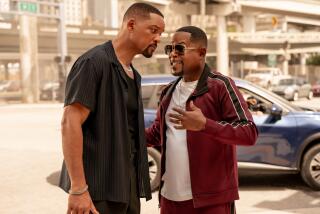A Second Look: ‘Ride With the Devil’
- Share via
The centerpiece of the 1999 Civil War drama “Ride With the Devil” is neither a glorious victory nor a crushing defeat. In fact, the movie’s climactic battle sequence is hardly a battle at all. The war had far bloodier days but few as purely wasteful as Aug. 21, 1863, when a loose federation of Confederate troops and the ad hoc militia known as Bushwhackers rode into Lawrence, Kan., and gunned down some 160 men and boys, most of them unarmed and some amid the cries of their pleading wives and children.
That “Ride With the Devil” builds to the Lawrence Massacre and not some better-known or less appalling event speaks volumes about both the film’s approach to American history and its calamitous box-office failure; the $35-million production took in less than $700,000. It couldn’t have helped that Universal chose to market the film as a dusty western full of hot young stars — sort of an upmarket “Young Guns.” But director Ang Lee came to believe that the film might have done better had he not bowed to contractual requirements and cut some 13 minutes that, while largely inessential, help to clarify the film’s conflicts and broaden its scope.
That the only reference to the director’s cut is found in small type on the back of Criterion’s Blu-ray and DVD versions indicates that Lee and James Schamus, who adapted Daniel Woodrell’s novel “Woe to Live On” and co-produced the film, intend for this version to supplant the earlier one, and there’s no reason why it shouldn’t. Although the restored scenes occasionally groan under the weight of supplementary exposition, “Ride With the Devil” feels as if it has found its natural shape. Without referring to the audio commentaries, you’d be hard pressed to see the seams.
While not overtly revisionist, “Ride With the Devil’s” account of the war is full of details that challenge the grade-school mythology of free North versus slave-happy South — or, conversely, Southern independents versus Northern aggressors. The movie’s most complex and apparently contradictory character is Daniel Holt, the freed slave played by Jeffrey Wright, whose decision to fight with the Bushwhackers is explained by his attachment to the dashing Southerner (Simon Baker) who purchased his freedom. During a break in hostilities, Holt and Jake Roedel ( Tobey Maguire), himself an outsider on account of his German birth, pass the time by reading captured letters from Northern soldiers, a diversion that turns to awkward silence when one soldier begins to contemplate the inhumanities of slavery. The moment has added force because the ideologies behind the war rarely make themselves felt, lost amid the chaotic skirmishes driven more by pride and vengeance than any cause, noble or otherwise.
The extended cut also allows more time for the movie’s prodigiously talented supporting cast, including Jim Caviezel, Tom Wilkinson, Celia Weston, Margo Martindale and a baby-faced Mark Ruffalo. At the time, critics pounced on some of Lee’s unconventional casting choices, especially “Scream’s” Skeet Ulrich as Jake’s childhood friend and the musician Jewel Kilcher as a flirtatious war widow. But hindsight vindicates Lee’s judgment. With his long, wavy hair, Ulrich could be a close cousin to Buffalo Bill, and Jewel’s guilelessness underlines the tender age of the movie’s characters.
Epic war movies are not often the place for nuanced performances, but Lee turns away from the action to register the toll taken on his protagonists, spending more time in domestic spaces, including a makeshift lean-to in which the Bushwhackers ride out the winter, than on the battlefield. Sometimes the two overlap, as leaderless combatants on both sides use houses as fortresses or take them as targets. It is surely no accident that the movie begins with a wedding and ends with a shotgun marriage, a union sundered and then made whole, even if the final coupling is far from ideal.
Criterion’s Blu-Ray brings out the rich palette of Frederick Elmes’ cinematography, particularly the lush, almost electric, green of the Plains states’ foliage. Even amid tragedy, the country’s breadbasket remains a verdant place, waiting for swords to be ploughshares again.
Clicking on Green Links will take you to a third-party e-commerce site. These sites are not operated by the Los Angeles Times. The Times Editorial staff is not involved in any way with Green Links or with these third-party sites.
More to Read
Only good movies
Get the Indie Focus newsletter, Mark Olsen's weekly guide to the world of cinema.
You may occasionally receive promotional content from the Los Angeles Times.









